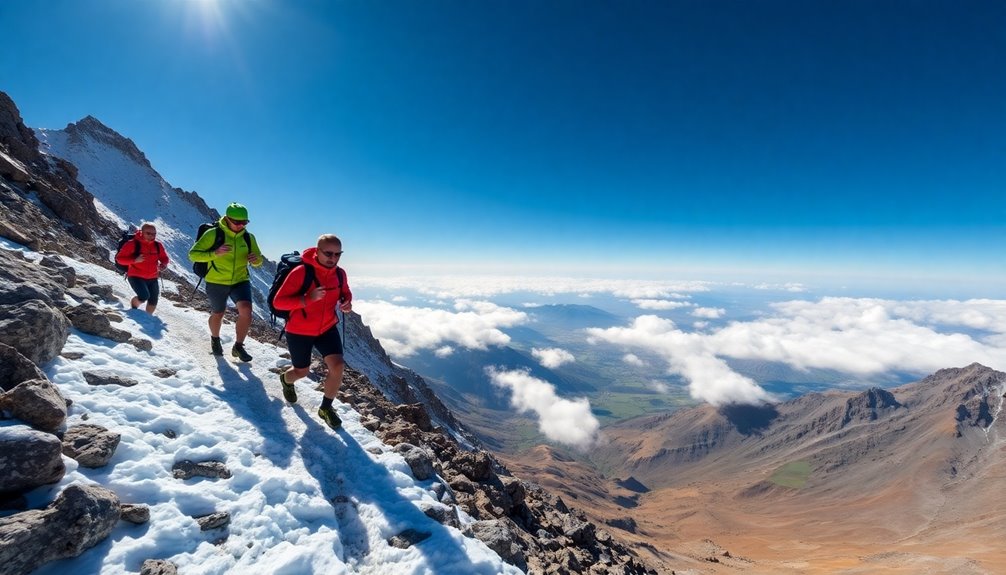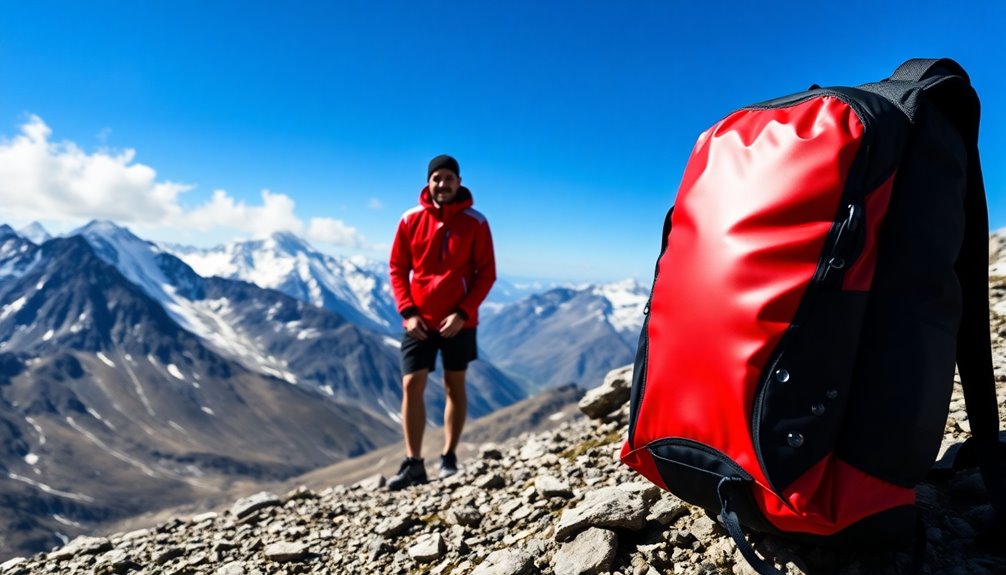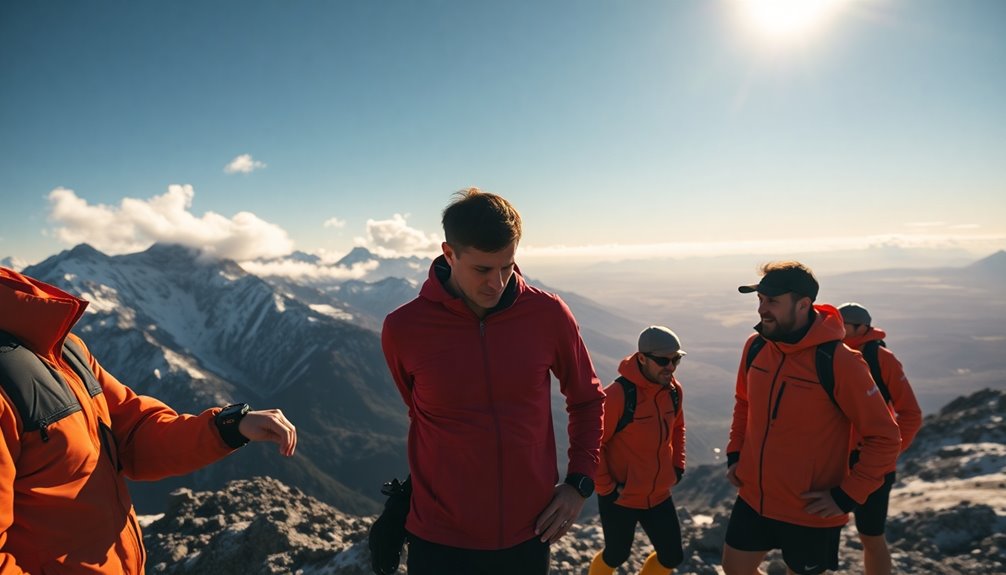To adjust your strategy for high-altitude training, focus on gradual acclimatization by limiting elevation gain to about 1,600 feet per day, and consider an extra day for every 3,300 feet climbed. Stay hydrated by drinking 3-4 liters of water daily and maintain a diet rich in carbohydrates. Incorporate strength and hill workouts, and monitor your heart rate closely to guarantee peak performance. There's much more you can learn about enhancing your high-altitude experience.
Key Takeaways
- Gradually ascend to avoid altitude sickness, limiting elevation gain to no more than 1,600 feet per day.
- Spend at least two weeks acclimatizing before racing to optimize performance at high altitudes.
- Monitor symptoms like headaches and dizziness closely, adjusting training plans accordingly to ensure safety.
- Focus on a carbohydrate-rich diet and hydration, aiming for 3-4 liters of water daily to support acclimatization.
- Incorporate strength training and hill workouts to enhance endurance and simulate conditions faced at higher elevations.
Understanding High Altitude and Its Effects

When you venture above 2,500 meters (8,200 feet), the effects of high altitude become increasingly noticeable due to reduced oxygen availability and lower air pressure.
You might experience altitude sickness, which includes symptoms like headaches, dizziness, and nausea. As you ascend, the risk of severe conditions, such as high-altitude pulmonary edema (HAPE) and high-altitude cerebral edema (HACE), heightens, especially around 5,500 meters (18,000 feet).
Your body needs time for acclimatization, an essential physiological adaptation that helps enhance performance and mitigates altitude sickness. This process involves gradually increasing your exposure to higher elevations. Additionally, understanding the mirroring dynamic can aid in recognizing how stress responses may impact your training and relationships at high altitudes.
Importance of Gradual Acclimatization

When you're tackling high altitudes, gradual acclimatization is key to your success and safety.
You need to recognize that everyone responds differently to elevation changes, so monitoring your symptoms is essential. Additionally, being aware of emotional responses can help in managing impulsive behavior during challenging conditions.
Acclimatization Timeframes
Gradual acclimatization is essential for anyone aiming to perform well at high altitudes. To reduce the risk of altitude sickness, you should increase your sleeping elevation by no more than 1,600 feet per day. For every 3,300 feet gained, spend an extra day acclimatizing. Symptoms of altitude sickness can peak 48-72 hours after arrival, making a gradual ascent vital.
| Elevation Gain (feet) | Recommended Acclimatization (days) |
|---|---|
| 0 – 3,300 | 1 |
| 3,300 – 6,600 | 2 |
| 6,600+ | 1 additional day for every 3,300 |
Optimal performance often requires at least 2 weeks of acclimatization before racing, allowing your body to fully adapt to the high-altitude environment. Additionally, maintaining a savings goal for your training expenses can help ensure you have the necessary funds to support your acclimatization process.
Individual Response Variability
Although individual responses to high altitude differ markedly, understanding these variations is essential for your acclimatization strategy. Factors like age, fitness level, and genetics can greatly influence how your body adapts.
To minimize the risk of altitude sickness, it's vital to ascend gradually—ideally, by no more than 1,600 feet per day. This allows your body to adjust, increasing heart rate and altering breathing patterns effectively. Spending 3-4 days at a high altitude enhances red blood cell production, improving your oxygen efficiency.
Pay attention to early signs of altitude sickness, such as headaches and dizziness, which indicate that your body needs more time to adapt. A thoughtful acclimatization approach can enhance your performance and safety at altitude. Additionally, establishing clear savings goals for your financial health can help support your training efforts by ensuring you have the resources needed for travel and equipment.
Monitoring Symptoms Effectively
Understanding your body's responses to altitude is just the beginning; monitoring symptoms effectively is equally vital.
Gradual acclimatization helps reduce the risk of altitude sickness, allowing your body to adapt to lower oxygen levels. As you ascend, increase your sleeping elevation by no more than 1,600 feet per day, and take an extra day to acclimatize for every 3,300 feet gained.
Keep a close eye on your symptoms—headaches, nausea, dizziness, and fatigue can all signal altitude sickness. Staying hydrated and maintaining a balanced diet are essential for effective acclimatization. Adequate sleep is also crucial for recovery during this process.
Regularly assess your appetite and energy levels to gauge how well your body is adapting. This proactive approach guarantees your high-altitude training remains safe and effective.
Best Practices for Hydration and Nutrition

When training at high altitudes, staying hydrated is essential for your performance and recovery. You should aim for at least 3-4 liters of water daily while focusing on a diet rich in carbohydrates to meet your increased energy needs. Remember to monitor your hydration levels by checking your urine color, as this can help you maintain ideal hydration. Additionally, incorporating nutrient-dense foods like chia seeds can provide essential minerals and support overall health during intense training.
Hydration Strategies at Altitude
Staying properly hydrated at high altitudes is critical for your performance and overall health. Aim to drink at least 3-4 liters of water daily to combat fluid loss from increased breathing rates.
This level of hydration, combined with a balanced diet rich in carbohydrates, will help your body meet the heightened metabolic demands due to lower oxygen availability.
To further enhance hydration, choose electrolyte-rich fluids, especially during prolonged activities, to replenish lost salts.
Monitoring your hydration levels is essential; check your urine color regularly to ascertain adequate intake.
Avoid excessive alcohol, as it can lead to dehydration and hinder acclimatization.
Nutritional Needs for Performance
To optimize your performance at high altitudes, prioritizing nutritional needs is essential.
First, focus on hydration; drink at least 3-4 liters of water daily to combat dehydration caused by lower humidity and increased respiratory water loss.
A balanced diet is vital, with 60-70% of your total calories coming from carbohydrates to meet your heightened energy demands.
Don't forget to include electrolyte-rich foods and drinks to replenish sodium, potassium, and magnesium, helping maintain hydration and muscle function.
It's also important to steer clear of excessive alcohol, as it can worsen dehydration and slow recovery.
Regularly monitor your hydration levels by checking urine color; pale yellow indicates good hydration, while dark yellow means it's time to drink more fluids. Additionally, consider using air purifiers to improve indoor air quality and further support your overall well-being during high-altitude training.
Effective Training Strategies for Altitude

As you prepare for high-altitude training, implementing effective strategies is essential for acclimatization and performance.
Start with a gradual ascent, increasing your sleeping elevation by no more than 1,600 feet daily, and allow extra acclimatization days for every 3,300 feet gained.
Focus on aerobic training exercises initially while gradually incorporating interval training as your body adjusts to reduced oxygen levels.
Keep a close eye on your hydration, increasing fluid intake to counteract high-altitude dehydration and maintain a balanced diet rich in carbohydrates to fuel your energy needs.
Adjust your workout intensity, starting with lower intensity sessions to help your body acclimatize before moving to more strenuous workouts.
Consider altitude simulation techniques, like high-altitude training masks, to prepare your body for these changes. Additionally, understanding energy efficiency ratings can help you select appropriate training equipment that supports optimal performance at higher elevations.
Monitoring Heart Rate and Performance

How can you guarantee your training remains effective at high altitude? Monitoring your heart rate is key. At higher elevations, reduced oxygen can spike your heart rate even during lighter workouts.
Using a heart rate monitor helps you stay within your ideal training zones, ensuring you don't overexert yourself. Keep in mind that altitude training can cause a 10-15% decrease in your maximum heart rate, so you'll need to adjust your intensity accordingly.
Pay attention to your heart rate recovery times post-exercise; they reveal how well you're acclimatizing. Additionally, tracking heart rate variability will offer insights into your body's response to altitude stress, allowing you to fine-tune your training plan for ideal adaptation. Implementing continuous improvement practices can enhance your overall training efficiency and effectiveness at high altitudes.
Safety Considerations During Altitude Training

While training at high altitudes can enhance your performance, it's important to prioritize safety to avoid serious health risks.
One of the key safety considerations is acclimatization; ascend no more than 1,600 feet daily and take extra rest days at higher elevations.
Staying well-hydrated is essential, so aim for 3-4 liters of water each day.
Be vigilant for symptoms of altitude sickness, like headaches, nausea, and fatigue. If these occur, it's crucial to respond quickly, as severe cases can lead to HAPE or HACE.
Monitor your heart rate closely during training to manage exertion levels, and consider consulting with a healthcare provider about prophylactic medications, such as acetazolamide, to reduce the risk of altitude sickness. Additionally, participating in family-friendly amenities can help maintain motivation and morale during your training sessions.
Incorporating Strength and Hill Workouts

Incorporating strength and hill workouts into your training regimen can greatly boost your performance at high altitudes.
Focus on these key elements to enhance your ability to tackle challenging terrains:
- Incorporate strength training to enhance muscle endurance.
- Target your legs and core for improved stability and power.
- Include hill workouts at least once a week to improve VO2 Max.
- Use interval training during hill workouts to simulate steep ascents.
- Carry a weighted backpack during training to mimic trekking conditions.
Managing Symptoms of Altitude Sickness

When you're at high altitudes, it's essential to recognize early symptoms of altitude sickness like headaches and dizziness.
Staying hydrated can make a significant difference, so aim for at least 3-4 liters of water daily.
Recognizing Early Symptoms
As you ascend to high altitudes, it's vital to recognize the early symptoms of altitude sickness, which can hit within hours.
Being aware allows for timely adjustments to your acclimatization strategy and activity level. Here are some symptoms to watch out for:
- Headache
- Nausea
- Dizziness
- Fatigue
- Difficulty breathing
These symptoms often worsen if you don't stay hydrated, as dehydration can exacerbate your condition.
It's important to drink plenty of water, especially during the initial days of your ascent.
Monitoring your body's responses, like changes in appetite and sleep patterns, can also help you catch altitude sickness early.
Effective Hydration Strategies
Staying properly hydrated is essential for managing altitude sickness, especially since the dry air and increased breathing at high elevations can quickly lead to dehydration.
You should aim to drink 3-4 liters of fluid daily to combat this. Incorporating electrolytes like sodium and potassium into your hydration routine helps maintain fluid balance, effectively reducing headaches and fatigue associated with altitude sickness.
Avoid excessive alcohol and caffeine, as they can worsen dehydration and elevate your symptoms. A diet rich in carbohydrates can also support hydration levels, as they help retain water and provide energy.
Finally, monitor your hydration by checking urine color: pale yellow indicates good hydration, while dark yellow signals dehydration.
The Role of Genetics in Altitude Adaptation

Genetics plays an essential role in how individuals adapt to high-altitude environments, influencing everything from oxygen utilization to susceptibility to altitude sickness.
Your genetic adaptations can greatly impact your performance and health while training at altitude. Here are some key factors to take into account:
- Increased hemoglobin levels enhance oxygen saturation.
- Specific genetic variants improve hypoxia tolerance.
- The EPAS1 gene regulates erythropoiesis in low-oxygen conditions.
- Genetic traits can lead to milder acute mountain sickness symptoms.
- Variations in the ACE gene affect aerobic capacity and endurance.
Understanding these genetic factors can help you tailor your high-altitude training strategy, optimizing your performance and minimizing the risks associated with altitude exposure.
Embrace your unique genetics to make the most of your training.
Preparing Mentally for High-Altitude Challenges

Altitude training isn't just about physical preparation; mental readiness is just as important. Developing mental resilience is essential for managing the perceived exertion you'll face, as you might experience a 20-30% reduction in performance compared to sea level.
Set realistic expectations about altitude challenges, like headaches and fatigue, which can affect your motivation. Utilize visualization techniques to mentally rehearse your performance and coping strategies in these demanding conditions.
Focus on the rewarding aspects of altitude training—breathtaking views and unique wildlife—to maintain your motivation during tough sessions. Regularly reflecting on past successful experiences can boost your confidence and mental fortitude, helping you manage anxiety related to altitude sickness.
Embrace this mental preparation to enhance your overall performance.
Frequently Asked Questions
What Are the Strategies for Altitude Training?
When you're focusing on altitude training, start by gradually acclimatizing, increasing your sleeping elevation no more than 1,600 feet per day.
Incorporate aerobic and interval training to enhance oxygen utilization. Stay hydrated—drink plenty of water and eat a balanced diet rich in carbohydrates.
You might also consider using high-altitude training masks during indoor sessions.
Ultimately, adjust your workout intensity, starting lower and gradually increasing as your body adapts to the altitude.
How Do You Get Adjusted to High Altitude?
Like climbing Everest, adjusting to high altitude takes patience and preparation.
Start by gradually increasing your sleeping elevation, adding no more than 1,600 feet daily. Hydration's key—drink plenty of fluids to fend off dehydration.
Begin with lower intensity workouts, focusing on aerobic exercises to help your body adapt. Keep an eye out for altitude sickness symptoms and modify your training as needed.
Consider altitude simulation techniques to further boost your acclimatization efforts.
How to Train Your Body for High Altitude?
To train your body for high altitude, start by gradually acclimatizing.
Increase your sleeping elevation by no more than 1,600 feet daily and take an extra day for every 3,300 feet gained.
Focus on aerobic exercises to boost oxygen efficiency, and incorporate interval training as you adapt.
Stay hydrated to combat altitude sickness and consider using high-altitude training masks during sea level workouts to prepare your body for the lower oxygen levels ahead.
How Do Athletes Adjust to High Altitude?
Picture yourself gasping for breath as you run beneath a vast, blue sky at high altitude.
You adjust by lowering your workout intensity initially, allowing your body to adapt to the thin air.
You'll focus on aerobic exercises to improve oxygen efficiency.
Hydration's key, so drink plenty of water.
As you acclimatize, you'll gradually incorporate interval training, tracking your progress to see how your endurance grows in this challenging environment.
Conclusion
Adjusting your strategy for high-altitude training might seem intimidating, but it's totally manageable with the right approach. You might worry that you won't adapt in time, but remember, gradual acclimatization is key. By focusing on hydration, nutrition, and tailored workouts, you'll boost your performance and resilience. Embrace the challenge, and soon you'll find that high-altitude training not only enhances your fitness but also builds your mental toughness. So go ahead, take that leap into the mountains!









